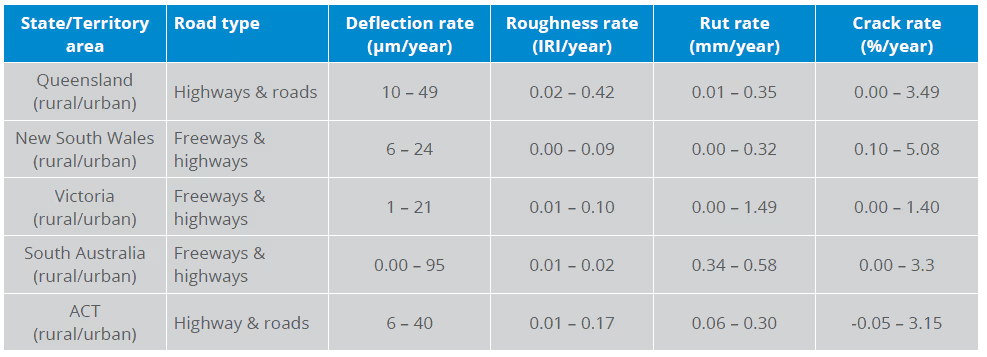

The Austroads-funded long-term pavement performance (LTPP) study ran from 1994 to 2018. Its four primary objectives were to:
These objectives were achieved using regular functional (roughness, rutting, cracking) and structural (deflection) observations on specific LTPP sites observations in conjunction with the long-term pavement performance maintenance (LTPPM) observational data. This observational data was collected from a range of in-service pavement LTPP and LTPPM sites set up for the study.
These objectives were also achieved in combination with the data obtained from the ALF experiments, under controlled environmental conditions and aimed at quantifying the effect of: (i) surface maintenance treatments and; (ii) increased axle loads (Martin 2010, 2011).
The deterioration rate of a pavement is a good indicator of pavement performance. Pavements are expected to deteriorate over time under traffic loading and climatic conditions. However, the deterioration process is often slowed due to the influence of surface maintenance and can be reversed due to the restorative impact of rehabilitation works.
The estimation of the deterioration rate, excluding the impact of either minor or major restorative works, was addressed by the ARRB in-house software tool that calculates the linear rate of progression (LRP) over part, or the whole, of the monitored pavement segment that is undergoing deterioration. The tool adopts a set of decision rules to validate each time-series data point for the calculation of the progression rate. The LRP software tool was written in an MS Excel macro and run on a spreadsheet with input data and output results worksheets attached to the file (Martin 2008).
The tool uses the maximum limit (ML), which is defined as the upper limit of consecutive deterioration change that can be acceptable, and the tolerance limit (TL), which is the maximum improved change condition allowed between two consecutive measurements, to tighten or relax the selection of input data. The ML and TL values set in the LRP interface for the calculation of progression rates for structural and functional distresses are given in Table 1.

Results of LRP processing for individual LTPP sites, the estimated rates of deterioration, are summarised in Table 2 for the various road types. The deterioration rate calculation requires a minimum number of three sequential valid data points. In the case where this condition is not satisfied, no valid result is produced by the tool. Table 2 summarises the range of observed rates of annual deterioration of deflection, roughness, rutting and cracking on the LTPP sites.

Comparative analysis studies of the LTPP pavement data with ALF experimental data were undertaken at an early stage of the project. The studies concluded that the pavement performance predictions made from ALF were generally comparable with that of the LTPP pavements (Clayton 2002, Tepper et al. 2002).
A comparison of the LTPP asphalt pavement sites’ performance with that of US SHRP-LTPP sites of similar loading and climate revealed that the sites from both groups experienced similar structural and functional deterioration, in terms of roughness and rutting (Austroads 2009). Cracking data was not available for the comparative analysis.
A number of road deterioration (RD) and works effects (WE) models were developed during the LTPP study. These included:
An investigation of the influence of surface maintenance treatments on pavement deterioration was based on the data collected from eight LTPPM sites from 2000 to 2018. This influence was assessed by treating each treatment as a variable while keeping all other factors – including pavement strength, traffic, climatic and topographic conditions – constant. Five different surface treatments were accommodated in any one LTPPM site.
The maintenance treatments were broadly classified into six groups as per Table 3. Routine maintenance, minimum maintenance, polymer modified binder (PMB) reseal and normal resealing occurred on every one of the eight LTPPM sites, whereas the geotextile reseal and a reseal with shape correction were only used on five and two sites respectively.

From Table 3 the following is observed:
After nearly 24 years of continuous monitoring experience, lessons were learnt about certain aspects of fieldwork, from the site establishment to the management and execution of the fieldwork program, which are summarised as follows:
The in-service pavement LTPP/LTPPM observational data was obtained through a rigorous monitoring approach that consumed a significant portion of the annual budget. The quality of this data is currently superior to that collected from a network survey.
The LTPP database and webpage will continue to exist as a valuable data source for research in pavement related areas. The data has been used by many researchers and is frequently used by academia inside and outside Australia. The LTPP database can be used to store additional data from other studies, such as the past local road deterioration study and any other future performance studies.
From the outset, the Australian LTPP study provided valuable pavement performance input to the US SHRP program. While the Australian sites were relatively limited in number, the initial intention was to use these as reference sites to ‘calibrate’ the performance of Australian pavements against the vastly numerically superior US SHRP study of approximately 1200 sites.
The LTPP study has fulfilled its original objectives. The study created an environment, or working platform, to facilitate the activities required to achieve the primary objectives of the study, such as tools for estimating the influence of climate on pavement distress and progression rates of pavement distress. In addition, technology and knowledge transfer activities involved establishing the LTPP/LTPPM database and webpage and the annual newsletter to promote further investigation and research. International activities involved the comparison of the performance of Australian LTPP sites with those of US-LTPP and a review of the 2002 AASHTO pavement design guide performance relationships to see if these were applicable to Australian LTPP sites.